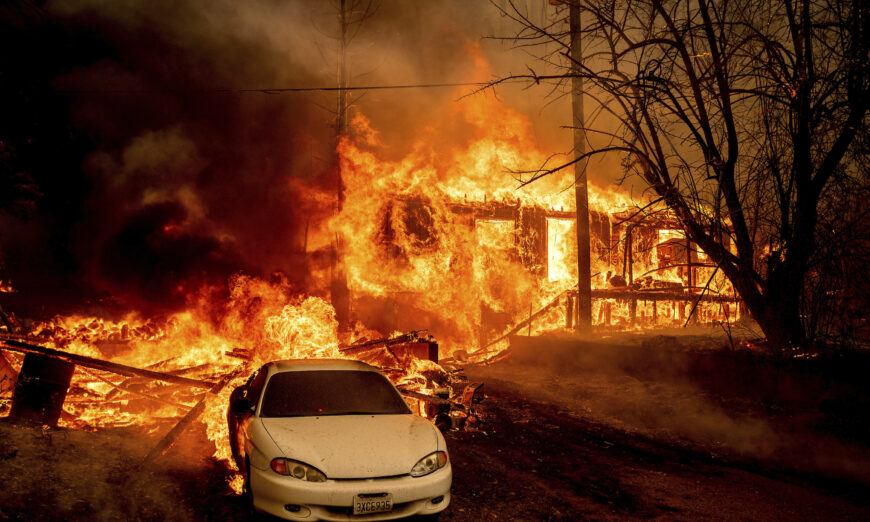Another Insurance Company Stops Offering Policies to Homeowners in California
Another major insurance provider has announced it’s no longer selling new policies for personal and business properties in California, becoming the latest insurer to reduce its footprint in the state amid inflationary pressures and growing exposure to wildfire risks. Allstate, the fourth-largest provider of casualty and property insurance in California, said in a statement that it had “paused” providing new homeowner policies in the Golden State last year so that it can “continue to protect current customers.” “The cost to insure new home customers in California is far higher than the price they would pay for policies due to wildfires, higher costs for repairing homes, and higher reinsurance premiums,” Allstate said in the statement. While the pause took place last year, it wasn’t widely covered until the San Francisco Chronicle and industry publications reported on it last week. An Allstate representative told KTLA that the change does not impact existing customers or their ability to renew their policies. An Allstate insurance company sign is seen in Miami, Fla., on Jan. 17, 2008. (Joe Raedle/Getty Images) California Insurers Pull Back Word that Allstate has halted sales of new insurance policies for home, condominium, or commercial properties in California comes on the heels of a similar decision last week by State Farm, the state’s biggest homeowner insurance provider. State Farm said that inflationary pressures and rising exposure to wildfire risks stood behind its decision to discontinue providing new policies to homeowners. In a recent statement, State Farm said it would “cease accepting new applications including all business and personal lines property and casualty insurance” effective May 27. State Farm said it “made this decision due to historic increases in construction costs outpacing inflation, rapidly growing catastrophe exposure, and a challenging reinsurance market.” As in the case of Allstate, existing customers will not be affected by the change. Flames consume a home on Triangle Rd. as the Oak Fire burns in Mariposa County, Calif., on July 23, 2022. (Noah Berger/AP Photo) ‘Turbulence in California’s Insurance Market’ The American Property Casualty Insurance Association (APCIA), a trade association for home, auto, and business insurers, said in a recent statement that “turbulence in California’s insurance market” harms residents as insurance companies face regulatory constraints. APCIA president and CEO, David Sampson, said in the letter that the cost of insurance has increased “dramatically” in recent times and that California regulations aren’t flexible enough to allow companies to raise rates to mitigate rising risk “due to climate change, historic economic inflation, and legal system abuse.” “Insurers must be able to cover the costs of future claims in setting rates. That includes being allowed to factor in the cost of reinsurance in rates. It also means being able to use proprietary, reliable catastrophic models,” Sampson wrote. He said one key problem is that California’s insurance market operates under an “outdated” statute dating back to 1988 that is too rigid to adapt to the increased risk of droughts and wildfires. He called for California’s insurance regulatory framework to be modernized. “The insurance market should not be reliant on a system developed 34 years ago, before the advent of the internet, email, and cell phones,” Sampson wrote. He said insurers are engaging with California state regulators and policymakers to “find forward-looking solutions to help California insurance consumers and work to rebuild the state’s insurance marketplace to bring back more options for consumers.” Besides regulatory reform, Sampson called for solutions to mitigate the risk of loss from natural catastrophes by enhancing safety, including creating “defensible space in the five feet around homes” and upgrading older homes to higher building code standards. “Insurers do not want to retrench in one of the nation’s most important markets, but cannot continue to operate and deliver on our promises when we cannot manage our own risk exposure,” he wrote. “Insurers must have the financial strength to deliver on our promises to policyholders when disaster strikes.” In its statement, State Farm said: “We pledge to work constructively with the CDI [California Department of Insurance] and policymakers to help build market capacity in California. “However, It’s necessary to take these actions now to improve the company’s financial strength. We will continue to evaluate our approach based on changing market conditions.” Inflation and Insurance In a statement reacting to the State Farm announcement, APCIA said that inflation was making “every aspect involved in an insurance claim” more expensive. “It is costing more and taking longer to rebuild homes after a covered loss,” said Mark Sektnan, APCIA vice president for state government relations. According to a 2022 report rel

Another major insurance provider has announced it’s no longer selling new policies for personal and business properties in California, becoming the latest insurer to reduce its footprint in the state amid inflationary pressures and growing exposure to wildfire risks.
Allstate, the fourth-largest provider of casualty and property insurance in California, said in a statement that it had “paused” providing new homeowner policies in the Golden State last year so that it can “continue to protect current customers.”
“The cost to insure new home customers in California is far higher than the price they would pay for policies due to wildfires, higher costs for repairing homes, and higher reinsurance premiums,” Allstate said in the statement.
While the pause took place last year, it wasn’t widely covered until the San Francisco Chronicle and industry publications reported on it last week.
An Allstate representative told KTLA that the change does not impact existing customers or their ability to renew their policies.

California Insurers Pull Back
Word that Allstate has halted sales of new insurance policies for home, condominium, or commercial properties in California comes on the heels of a similar decision last week by State Farm, the state’s biggest homeowner insurance provider.
State Farm said that inflationary pressures and rising exposure to wildfire risks stood behind its decision to discontinue providing new policies to homeowners.
In a recent statement, State Farm said it would “cease accepting new applications including all business and personal lines property and casualty insurance” effective May 27.
State Farm said it “made this decision due to historic increases in construction costs outpacing inflation, rapidly growing catastrophe exposure, and a challenging reinsurance market.”
As in the case of Allstate, existing customers will not be affected by the change.

‘Turbulence in California’s Insurance Market’
The American Property Casualty Insurance Association (APCIA), a trade association for home, auto, and business insurers, said in a recent statement that “turbulence in California’s insurance market” harms residents as insurance companies face regulatory constraints.
APCIA president and CEO, David Sampson, said in the letter that the cost of insurance has increased “dramatically” in recent times and that California regulations aren’t flexible enough to allow companies to raise rates to mitigate rising risk “due to climate change, historic economic inflation, and legal system abuse.”
“Insurers must be able to cover the costs of future claims in setting rates. That includes being allowed to factor in the cost of reinsurance in rates. It also means being able to use proprietary, reliable catastrophic models,” Sampson wrote.
He said one key problem is that California’s insurance market operates under an “outdated” statute dating back to 1988 that is too rigid to adapt to the increased risk of droughts and wildfires.
He called for California’s insurance regulatory framework to be modernized.
“The insurance market should not be reliant on a system developed 34 years ago, before the advent of the internet, email, and cell phones,” Sampson wrote.
He said insurers are engaging with California state regulators and policymakers to “find forward-looking solutions to help California insurance consumers and work to rebuild the state’s insurance marketplace to bring back more options for consumers.”
Besides regulatory reform, Sampson called for solutions to mitigate the risk of loss from natural catastrophes by enhancing safety, including creating “defensible space in the five feet around homes” and upgrading older homes to higher building code standards.
“Insurers do not want to retrench in one of the nation’s most important markets, but cannot continue to operate and deliver on our promises when we cannot manage our own risk exposure,” he wrote.
“Insurers must have the financial strength to deliver on our promises to policyholders when disaster strikes.”
In its statement, State Farm said: “We pledge to work constructively with the CDI [California Department of Insurance] and policymakers to help build market capacity in California.
“However, It’s necessary to take these actions now to improve the company’s financial strength. We will continue to evaluate our approach based on changing market conditions.”
Inflation and Insurance
In a statement reacting to the State Farm announcement, APCIA said that inflation was making “every aspect involved in an insurance claim” more expensive.
“It is costing more and taking longer to rebuild homes after a covered loss,” said Mark Sektnan, APCIA vice president for state government relations.
According to a 2022 report released by Policygenius, home insurance rates in California jumped by 10 percent between May 2021 and May 2022.
“There’s inflation that’s taken place, so the cost to rebuild a home costs quite a bit more than it used to,” said Janet Ruiz, director of strategic communications at the Insurance Information Institute.
“There’s also a shortage of contractors. And we’re seeing hotter, drier weather—and more wind—which leads to more wildfires. So, all these things are coming into play at the same time.”
In his statement, Sektnan pointed to the “outdated” 1988 statute and insurance regulatory framework that doesn’t let insurance companies adapt to increased risks associated with droughts and wildfires.
He said that in order for the California insurance market to expand its capacity and availability of coverage for personal and business properties, insurers need “greater stability and regulatory flexibility to navigate the current difficult market conditions and manage rapidly evolving risk.”
“The California Department of Insurance (CDI) is working with insurers towards achieving adequate rates and making other market improvements because the admitted market continues to struggle with inadequate rates that don’t cover the increased risks caused by climate change and the growing number of communities in wildfire-prone areas,” Sektnan added.
The insurance squeeze has also affected parts of California where the wildfire risk is low, such as San Francisco.
Real estate agents cited by the Los Angeles Times said that some deals in San Francisco have fallen through because potential buyers couldn’t get home insurance, which is a key part of getting a mortgage.












